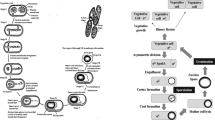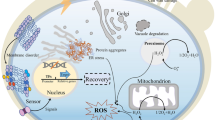Abstract
A short heat treatment (1 min or 3 min) of yeast ascospores resulted in a tenfold increase in the activity of trehalase as measured in extracts made after the heat shock. The optimal temperature was about 52°–54°C. The heat stability of trehalase in spore extracts was much lower than in the intact spores. When the cyclic-AMP level was measured in the spores during the heat treatment, a steady decrease was found. In these experiments the spore samples were immediately frozen in liquid nitrogen after the heat treatment. However, when the spores were first cooled with a large amount of ice-cold distilled water, as was done for the experiments on trehalase activation, an increase of the cyclic-AMP level was found which was about two-to threefold at the optimal temperature. When the activity of trehalase was measured after heating of the spores followed by rapid freezing in liquid nitrogen, no activation of trehalase was observed. Control experiments showed that trehalase was not destroyed by the freezing procedure. These results demonstrate that both the activation of trehalase and the increase of the cyclic-AMP level occur during the cooling of the spores and not during the heat treatment itself. They suggest possible involvement of cyclic AMP in the heat activation process of trehalase.
Similar content being viewed by others
Literature Cited
Londesborough, J. 1982. Cyclic nucleotide-dependent inactivation of yeast fructose-1,6-bisphosphatase by ATP. FEBS Letters144:269–272.
Lowry, O. H., Rosebrough, N. J., Farr, A. L., Randall, R. J. 1951. Protein measurement with the Folin phenol reagent. Journal of Biological Chemistry193:265–275.
Ortiz, C. H., Maia, J. C. C., Tenan, M. N., Braz-Padrão, G. R., Mattoon, J. R., Panek, A. D. 1983. Regulation of yeast trehalase by a monocyclic, cyclic AMP-dependent phosphorylation-dephosphorylation cascade system. Journal of Bacteriology153:644–651.
Pall, M. L. 1977. Cyclic, AMP and the plasma membrane potential inNeurospora crassa. Journal of Biological Chemistry252:7146–7150.
Pall, M. L. 1981. Adenosine 3′,5′-phosphate in fungi. Microbiological Reviews45:462–480.
Rudolph, H., Ochsen, B. 1969. Trehalose-Umsatz wärmeaktivierter Sporen vonPhycomyces blakesleeanus. Archives of Microbiology65:163–171.
Slayman, C. L. 1977. Energetics and control of transport inNeurospora crassa, pp. 69–86. In: Jungreis, A., Hodges, T. K., Kleinzeller, A., Schultz, S. G. (eds.), Water relations in membrane transport in plants and animals. New York: Academic Press.
Thevelein, J. M., Den Hollander, J. A., Shulman, R. G. 1982. Changes in the activity and properties of trehalase during early germination of yeast ascospores: correlation with trehalose breakdown as studied by in vivo13C NMR. Proceedings of the National Academy of Sciences of the United States of America79:3503–3507.
Thevelein, J. M., Jones, K.-A., 1983. Reversibility characteristics of glucose-induced trehalase activation associated with the breaking of dormancy in yeast ascospores. European Journal of Biochemistry136:583–587.
Thevelein, J. M., Van Laere, A. J., Beullens, M., Van Assche, J. A., Carlier, A. R. 1983. Glucose-induced trehalase activation and trehalose mobilization during early germination ofPhycomyces blakesleeanus spores. Journal of General Microbiology129:719–726.
Trevillyan, J. M., Pall, M. L. 1979. Control of cyclic adenosine 3′,5′-monophosphate levels by depolarizing agents in fungi. Journal of Bacteriology138:397–403.
Van Assche, J. A., Carlier, A. R. 1975. Some properties of trehalase fromPhycomyces blakesleeanus. Biochimica Biophysica Acta391:154–161.
Van Assche, J. A., Carlier, A. R., Dekeersmaeker, H. I. 1972. Trehalase activity in dormant and activated spores ofPhycomcces blakesleeaus. Planta103:327–333.
Van Assche, J. A., Carlier, A. R., Van Tieghem, L. L. C. 1977. The effect of gamma radiation on breaking of dormancy inPhycomyces spores. Archives of Microbiology113:95–97.
Van Assche, J. A., Van Laere, A. J., Carlier, A. R. 1978. Trehalose metabolism, in dormant and activated spores ofPhycomyces blakesleeanus Burgeff. Planta139:171–176.
Van der Plaat, J. B. 1974. Cyclic 3′,5′-adenosine monophosphate stimulates trehalose degradation in Baker's yeast. Biochemical and Biophysical Research Communications56:580–587.
Wiemken, A., Schellenberg, M. 1982. Does a cyclic AMP-dependent phosphorylation initiate the transfer of trehalase from the cytosol into the vacuoles inSaccharomyces cerevisiae? FEBS Letters150:329–331.
Author information
Authors and Affiliations
Rights and permissions
About this article
Cite this article
Thevelein, J.M. Activation of trehalase by heat shock in yeast ascospores: Correlation with total cellular cyclic-AMP content. Current Microbiology 10, 159–164 (1984). https://doi.org/10.1007/BF01576778
Issue Date:
DOI: https://doi.org/10.1007/BF01576778




